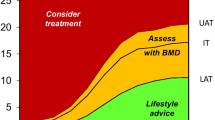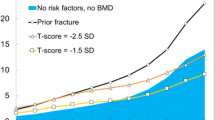Abstract
Summary
We compared the utility of the current Iranian guidelines that recommend treatment in women with a T-score ≤ − 2.5 SD with a FRAX-based intervention threshold equivalent to women of average BMI with a prior fragility fracture. Whereas the FRAX-based intervention threshold identified women at high fracture probability, the T-score threshold was less sensitive, and the associated fracture risk decreased markedly with age.
Introduction
The fracture risk assessment algorithm FRAX® has been recently calibrated for Iran, but guidance is needed on how to apply fracture probabilities to clinical practice.
Methods
The age-specific ten-year probabilities of a major osteoporotic fracture were calculated in women with average BMI to determine fracture probabilities at two potential intervention thresholds. The first comprised the age-specific fracture probabilities associated with a femoral neck T-score of − 2.5 SD, in line with current guidelines in Iran. The second approach determined age-specific fracture probabilities that were equivalent to a woman with a prior fragility fracture, without BMD. The parsimonious use of BMD was additionally explored by the computation of upper and lower assessment thresholds for BMD testing.
Results
When a BMD T-score ≤ − 2.5 SD was used as an intervention threshold, FRAX probabilities in women aged 50 years was approximately two-fold higher than in women of the same age but with an average BMD and no risk factors. The relative increase in risk associated with the BMD threshold decreased progressively with age such that, at the age of 80 years or more, a T-score of − 2.5 SD was actually protective. The 10-year probability of a major osteoporotic fracture by age, equivalent to women with a previous fracture rose with age from 4.9% at the age of 50 years to 17%, at the age of 80 years, and identified women at increased risk at all ages.
Conclusion
Intervention thresholds based on BMD alone do not effectively target women at high fracture risk, particularly in the elderly. In contrast, intervention thresholds based on fracture probabilities equivalent to a “fracture threshold” target women at high fracture risk.


Similar content being viewed by others
References
World Health Organization (1994) Assessment of fracture risk and its application to screening for postmenopausal osteoporosis. Geneva
Kanis JA, Melton LJ 3rd, Christiansen C, Johnston CC, Khaltaev N (1994) The diagnosis of osteoporosis. J Bone Min Res. 9(8):1137–1141
Kanis JA, McCloskey EV, Johansson H, Oden A, Melton LJ, Khaltaev N (2008) A reference standard for the description of osteoporosis. Bone [cited 2017 Jun 6];42(3):467–75. Available from: http://www.ncbi.nlm.nih.gov/pubmed/18180210
Marshall D, Johnell O, Wedel H (1996) Meta-analysis of how well measures of bone mineral density predict occurrence of osteoporotic fractures. BMJ [cited 2019 Feb 18];312(7041):1254–9. Available from: http://www.ncbi.nlm.nih.gov/pubmed/8634613
Johnell O, Kanis JA, Oden A, Johansson H, De Laet C, Delmas P et al (2005) Predictive value of BMD for hip and other fractures. J Bone Miner Res [cited 2019 Apr 9];20(7):1185–94. Available from: https://doi.org/10.1359/JBMR.050304
Osteoporosis Research Center E and MRI (2014) Osteoporosis guideline. Endocrinology and Metabolism Research Institute, Tehran
El-Hajj Fuleihan G, Adib G, Nauroy L (2011) Epidemiology, costs & burden of osteoporosis in 2011. The Middle East & Africa regional audit. Available from: https://www.iofbonehealth.org/data-publications/regional-audits/middle-east-africa-audit
Kanis JA, Johnell O (2005) Requirements for DXA for the management of osteoporosis in Europe. Osteoporos Int [cited 2019 Apr 9];16(3):229–38. Available from: http://www.ncbi.nlm.nih.gov/pubmed/15618996
Khashayar P, Aghaei Meybodi HR, Homami MR, Heshmat R, Larijani B (2010) The prevalence of osteoporosis in an iranian population. J Clin Densitom [cited 2016 Nov 4];13(1):112. Available from: http://linkinghub.elsevier.com/retrieve/pii/S1094695010000235
Ghafoori S, Keshtkar A, Khashayar P, Ebrahimi M, Ramezani M, Mohammadi Z et al (2014) The risk of osteoporotic fractures and its associating risk factors according to the FRAX model in the Iranian patients: a follow-up cohort. J Diabetes Metab Disord 13(1)
Kanis JA on behalf of the World Health Organization Scientific Group (2007) Assessment of osteoporosis at the primary health care level. [cited 2017 Jun 6]. Available from: https://www.sheffield.ac.uk/FRAX/pdfs/WHO_Technical_Report.pdf
Kanis JA, McCloskey EV, Johansson H, Strom O, Borgstrom F, Oden A et al (2008) Case finding for the management of osteoporosis with FRAX®—assessment and intervention thresholds for the UK. Osteoporos Int [cited 2019 Apr 9];19(10):1395–408. Available from: http://www.ncbi.nlm.nih.gov/pubmed/18751937
Kanis JA, Harvey NC, Cooper C, Johansson H, Odén A, McCloskey EV et al (2016) A systematic review of intervention thresholds based on FRAX. Arch Osteoporos [cited 2019 Apr 9];11(1):25. Available from: http://www.ncbi.nlm.nih.gov/pubmed/27465509
Looker AC, Wahner HW, Dunn WL, Calvo MS, Harris TB, Heyse SP et al (1998) Updated data on proximal femur bone mineral levels of US adults. Osteoporos Int [cited 2019 Apr 9];8(5):468–89. Available from: http://www.ncbi.nlm.nih.gov/pubmed/9850356
De Laet C, Kanis JA, Odén A, Johanson H, Johnell O, Delmas P et al (2005) Body mass index as a predictor of fracture risk: a meta-analysis. Osteoporos Int [cited 2019 Apr 9];16(11):1330–8. Available from: http://link.springer.com/10.1007/s00198-005-1863-y
Kanis JA, Oden A, Johnell O, Johansson H, De Laet C, Brown J et al (2007) The use of clinical risk factors enhances the performance of BMD in the prediction of hip and osteoporotic fractures in men and women. Osteoporos Int [cited 2019 Apr 9];18(8):1033–46. Available from: http://www.ncbi.nlm.nih.gov/pubmed/17323110
Johansson H, Oden A, Johnell O, Jonsson B, de Laet C, Oglesby A et al (2004) Optimization of BMD measurements to identify high risk groups for treatment-a test analysis. J Bone Miner Res [cited 2019 Apr 9];19(6):906–13. Available from: http://doi.wiley.com/10.1359/jbmr.2004.19.6.906
Leslie WD, Majumdar SR, Lix LM, Johansson H, Oden A, McCloskey E et al (2012) High fracture probability with FRAX® usually indicates densitometric osteoporosis: implications for clinical practice. Osteoporos Int [cited 2019 Apr 9];23(1):391–7. Available from: http://www.ncbi.nlm.nih.gov/pubmed/21365460
Kanis JA, Cooper C, Rizzoli R, Reginster J-Y (2019) European guidance for the diagnosis and management of osteoporosis in postmenopausal women. Osteoporos Int [cited 2019 Apr 9];30(1):3–44. Available from: http://link.springer.com/10.1007/s00198-018-4704-5
Johansson H, Azizieh F, al Ali N, Alessa T, Harvey NC, McCloskey E et al (2017) FRAX- vs. T-score-based intervention thresholds for osteoporosis. Osteoporos Int [cited 2019 Apr 9];28(11):3099–105. Available from: http://www.ncbi.nlm.nih.gov/pubmed/28782072
Grigorie D, Sucaliuc A, Johansson H, Kanis JA, McCloskey E (2013) Incidence of hip fracture in romania and the development of a romanian FRAX model. Calcif Tissue Int [cited 2019 Apr 9];92(5):429–36. Available from: http://link.springer.com/10.1007/s00223-013-9697-7
Kanis JA, McCloskey E V, Harvey NC, Johansson H, Leslie WD (2015) Intervention thresholds and the diagnosis of osteoporosis. J Bone Miner Res [cited 2019 Apr 9];30(10):1747–53. Available from: http://www.ncbi.nlm.nih.gov/pubmed/26390977
Kanis JA, Johnell O, Oden A, Jonsson B, De Laet C, Dawson A (2000) Risk of hip fracture according to the World Health Organization criteria for osteopenia and osteoporosis. Bone [cited 2019 Apr 9];27(5):585–90. Available from: http://www.ncbi.nlm.nih.gov/pubmed/11062343
Johansson H, Kanis JA, Oden A, Johnell O, McCloskey E (2009) BMD, clinical risk factors and their combination for hip fracture prevention. Osteoporos Int [cited 2019 Apr 9];20(10):1675–82. Available from: http://www.ncbi.nlm.nih.gov/pubmed/19291344
Compston J, Cooper A, Cooper C, Gittoes N, Gregson C, Harvey N et al (2017) UK clinical guideline for the prevention and treatment of osteoporosis. Arch Osteoporos [cited 2019 Apr 9];12(1):43. Available from: http://www.ncbi.nlm.nih.gov/pubmed/28425085
Acknowledgments
This paper is based on a similar paper prepared for Romania [21] but uses the Iranian rather than Romanian FRAX model.
Author information
Authors and Affiliations
Corresponding author
Ethics declarations
Conflicts of interest
None.
Additional information
Publisher’s note
Springer Nature remains neutral with regard to jurisdictional claims in published maps and institutional affiliations.
Rights and permissions
About this article
Cite this article
Khashayar, P., Keshtkar, A., Ostovar, A. et al. FRAX-based intervention and assessment thresholds for osteoporosis in Iran. Osteoporos Int 30, 2225–2230 (2019). https://doi.org/10.1007/s00198-019-05078-4
Received:
Accepted:
Published:
Issue Date:
DOI: https://doi.org/10.1007/s00198-019-05078-4




